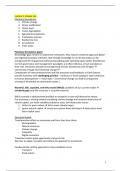Class notes
Extensive lecture summary Sustainable Finance & Investments (grade 7.5)
- Course
- Institution
Extensive summary for the course Sustainable Finance and investments at Vrije Universiteit. This summary helped me to get an grade 7.5/10 at the exam. The course is given at VU by F Hamelink.
[Show more]



